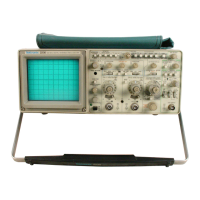Operating Information—2230 Service
acquiring and viewing both channel input signals
at sweep rates of 0.5 ms per division and faster.
Channel 1 and Channel 2 STORE mode signals
are acquired on alternate acquisition cycles at
one-half the sampling rate of a single-channel
acquisition.
CHOP—Switches the nonstore display between
the Channel 1 and Channel 2 vertical input sig
nals during the sweep. The chopped switching
rate for NON STORE mode (CHOP frequency) is
approximately 500 kHz. Chopped STORE mode
signals are acquired on alternate time-base clock
cycles with each channel being acquired at one-
half the sampling rate of a single-channel acquisi
tion. In STORE mode at sweep speeds of 5 ys
per division or faster, CHOP becomes ALT mode.
BW LIMIT Switch—When pressed in while in
NON STORE mode, the bandwidth of the vertical
amplifier system and the A Trigger system is lim
ited to approximately 20 MHz. This reduces
interference from unwanted high-frequency sig
nals when viewing low-frequency signals. In
STORE mode, pressing in the BW LIMIT switch
reduces only the trigger bandwidth. Press the
switch a second time to release the switch and
regain full bandwidth.
X-Y Switch—Automatically selects X-Y mode
when pressed in. The CH 1 input signal provides
horizontal deflection for X-Y displays, and the
CH 2 input signal provides vertical deflection, in
STORE mode, CH 1 and CH 2 signals are
acquired in a chopped manner with no more than
100 ns between corresponding sample points on
opposite channels, with the CH 1 signal being
sampled before the CH 2 signal. The sampling
mode and sampling rate are controlled by the A
or the B SEC/DIV switch (depending on the Hor
izontal Display mode). The X-Y waveform is
acquired in SAMPLING mode and displayed with
dots. Set the SEC/DIV controls to obtain at least
10 samples per cycle of the highest frequency
component in both the X and the Y input signals.
The sampling rate is determined by the formula
50/(SEC/DIV) Hz.
(l6) Vertical POSITION Controls—Control the vertical
display position of the CH 1 and CH 2 signals.
In STORE mode, the controls determine the vertical
position of displayed waveforms during acquisition
and in SAVE mode. Any portions of a signal being
acquired that are outside the dynamic range of the
A/D converter are blanked when positioned on
screen. The Vertical POSITION controls can also
reposition a vertically expanded SAVE waveform so
that portions of the waveform outside the graticule
area can be observed.
In NON STORE X-Y mode, the CH 2 POSITION con
trol vertically positions the display, the horizontal
POSITION control positions the display horizontally,
and the CH 1 POSITION control is not active. In
STORE mode, the CH 1 POSITION control is active,
and both it and the Horizontal POSITION control
affect the horizontal position of the displayed
waveform.
(l7 ) A/B SWIP SEP Control (NON STORE only)—While
in NON STORE mode, vertically positions the B
Sweep trace with respect to the A Sweep trace
when the HORIZONTAL MODE is BOTH.
M{H PRB ADJ Connector—Provides an approximately
0.5 V, negative-going, square-wave voltage (at
approximately 1 kHz) for compensating voltage
probes and checking the operation of the
oscilloscope's vertical system. It is not intended to
verify the accuracy of the vertical gain or the hor
izontal time-base circuitry.
(19) GND Connector—Provides an auxiliary ground con
nection directly to the instrument chassis via a
banana-tip jack.
HORIZONTAL
Refer to Figure 2-6 for location of items 20 through 26.
(20) SEC/DIV Switches— Determine the SEC/DIV setting
for both the NON STORE sweeps and the STORE
mode waveform acquisitions. To obtain calibrated A
and B NON STORE sweeps, the Variable SEC/DIV
control must be in the CAL detent.
In STORE mode, the SEC/DIV switches determine
the default acquisition and display modes, set the
sampling rate, and establish the seconds-per-division
scale factor of the displayed waveforms. The
SEC/DIV parameters displayed on the crt readout
are for the waveforms identified by CURSORS.
Table 2-2 lists the default Storage and Display
modes with respect to the SEC/DIV switch setting
and the selected Trigger mode. The default modes
may be changed by selecting the Acq Mode Setup
Table in the menu. Waveforms of SCAN, and ROLL
displays are updated one data point at a time. All
data points of a RECORD display are updated at the
same time (total record replacement).
2-8

